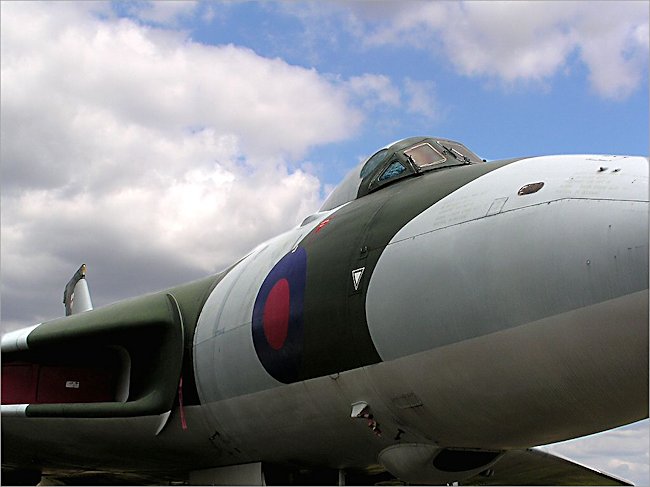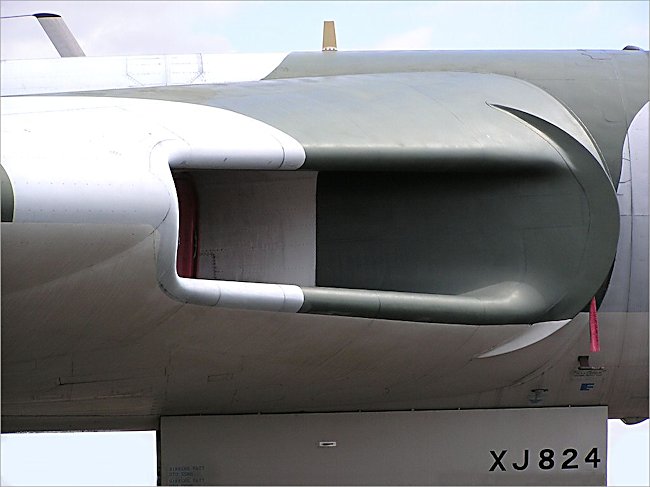RAF Avro Vulcan Delta Wing Bomber
The RAF Avro Vulcan tactical strike nuclear bomber was Britain's response to the Cold War Soviet threat. It was more agile that the USAF B-52. The Vulcan could do a full role. It was first designed to fly at altitude and deliver nuclear or conventional bombs over enemy territory. The development of surface to air missiles SAMS lead to a change in mission. The Vulcan was now required to fly under the enemy's radar to deliver their deadly load.
They were upgraded with more powerful engines, in-flight refueling ability, electronic counter measures ECM warfare systems for defense and attack. This variant was called the B.2 Vulcan. It could carry a stand off nuclear missile Blue Steel which could be fired 100 miles away. With the introduction of Polaris intercontinental ballistic missiles fired from the Royal Navy's submarines force the RAF's V-Force nuclear bombers became redundant.

No Vulcan had ever dropped a bomb in anger but then they came into their own during the Falklands War in 1982. The British Government wanted the ability to bomb the main Falkland Island airfield outside Port Stanley before the British fleet arrived to retake the island from the Argentina invaders. The Vulcan bombers were 3,886 miles away from the target. The operation was given the code name Black Buck. The nearest airfield was on Ascension Island in Mid Atlantic. It would take eight hours to fly on over the target and multiple in-flight refuelling sessions.
It took eleven Victor tankers to put one Vulcan Bomber over the enemy held airfield. The aim of the mission was to put at least one bomb on the runway. As the Vulcan approached the target, 10 miles out the AEO detected an Argentine gun-laying radar trying to lock on. The crew deployed their American ALQ-101 jamming pod which disrupted the radar. The bombs were dropped two miles out from Port Stanley Airstrip at a diagonal attack vector. This laid twenty one 1,000lb bombs in a diagonal line that crosses the runway. One bomb hit the centre of the runway and a second hit the edge of the runway. Other bombs hit fuel containers, ammo stores and the golf course.

The message had been sent to Buenos Aires - Argentina main land is not out of range. Argentine morale was hit. British moral at first blood sky rocketed. The damaged Airfield was soon repaired but Argentine fighters were kept back on the Argentine mainland to defend against a possible RAF Vulcan bomber attack on Argentina. That was the major success of the Vulcan attacks.
A number of other Black Buck missions were flown. The next day Black Buck 2 was a repeat of Black Buck 1 but it did not have as much success as the bombs missed the runway. Black Bucks 3 and 4 were cancelled as there were problems with the refueling victors. Black Buck 5 was an anti radar mission. The Argentinian Westinghouse AN/TPS 43F radar had been providing attack information for the Argentinean Super Etendards and Sky Hawks Jets The British Royal Navy Task Force was positioned off the Falklands islands. The American Government covertly supplied the RAF with Shrike anti Radar missiles. 200 meters out the attacking Vulcan descended to 300 ft above the sea. At 20 nm the pilot climbed to 16,000 ft. After 40 minutes the crew located the TPS 43 radar and fired its two Shrike missiles. One of the missiles exploded 10 meters from the Radar installation causing minor blast damage the other totally missed. The Argentinean crew wisely shut down the radar as they feared a further attack. This enabled a Sea Harrier raid to attack Port Stanley relatively un-opposed.

During these attacks the Vulcan Bomber broke two records. One for the longest mission in the history of air warfare 16 hours (later broken by a B-52 during the Gulf war in 1991) and the longest distance traveled to execute a bombing run. Black Buck 6 mission was designed to attack the same radar installation but the system was not turned on and therefore could not be locked on by the Vulcan's anti radar missiles. The pilot did not want to return to base without a strike so he moved on to his secondary target the Sky Guard/Super Oerlikon AAA installations that protected Port Stanley. He enticed the Sky Guard crew to turn their radar on and illuminate the Vulcan by flying low and within range of their system. They locked onto the Vulcan but the pilot managed to shake the lock and fired two of his four Shrike anti radar missiles.
This time one successfully hit and destroyed the radar killing four Argentinean radar operators. The Vulcan had to land in Brazil when its refuelling arm was damaged. The crew were held in open arrest but well treated. After seven days they were allowed to return to the Ascension Island. One of the American Shrike Missiles was still attached to the aircraft when it landed as its release mechanism had failed. This was rather embarrassing to both the British and American Governments as the American Government was officially neutral. Black Buck Mission 7 was the final active service operation where it delivered airburst bombs onto Port Stanley airfield. The South Atlantic battle caused only a short extension to the Avro Vulcan's retirement date. In March 1984, two years after the end of the Falkland War, the last RAF Vulcan Squadron was disbanded.
Avro Vulcan Books


Tweet